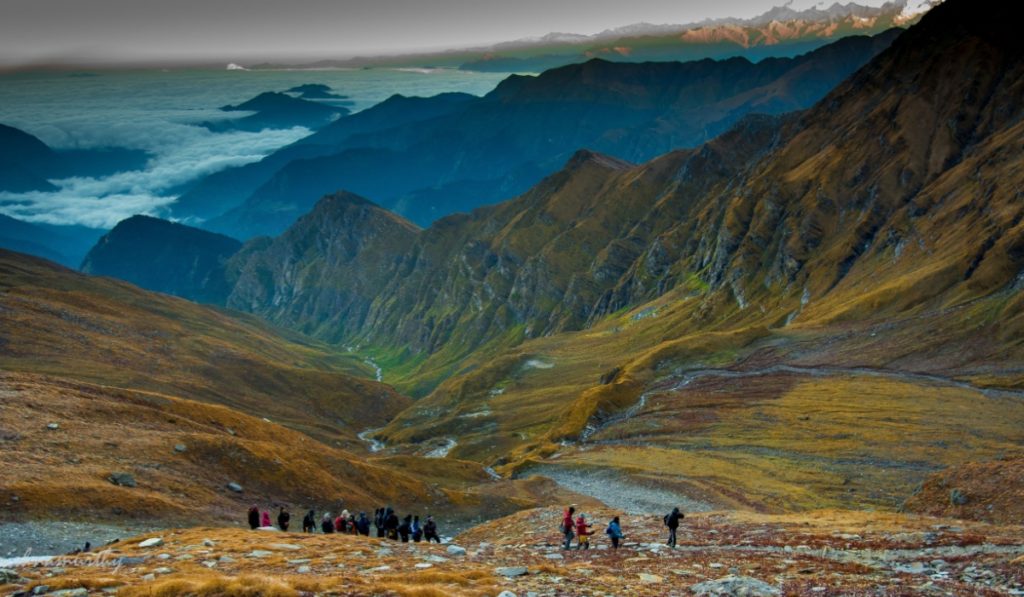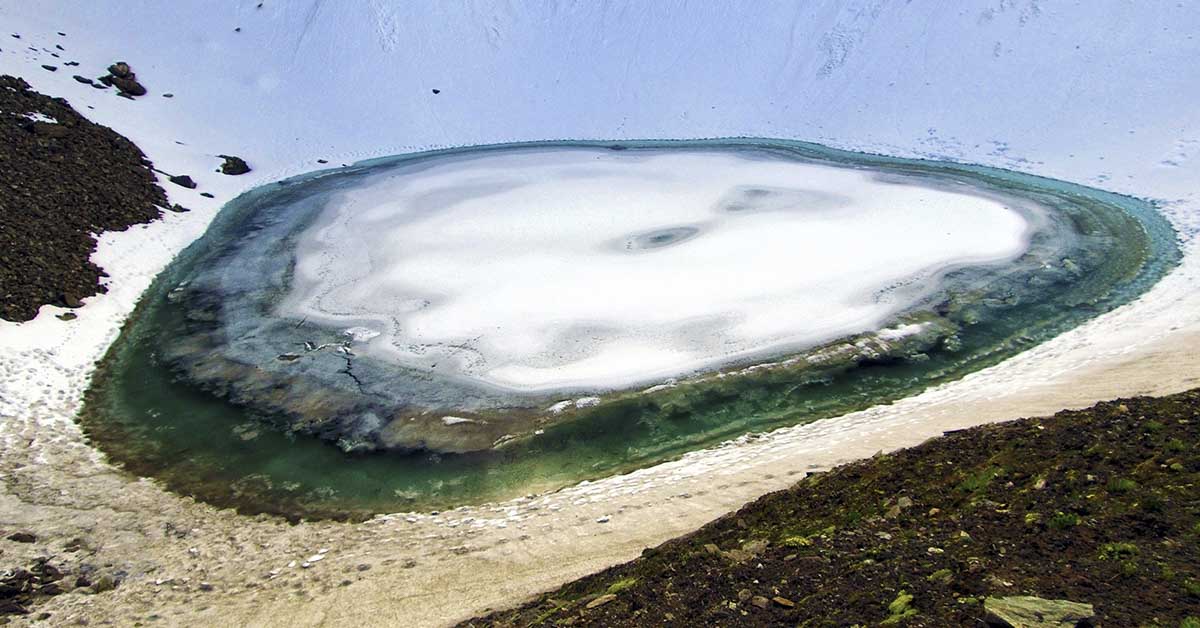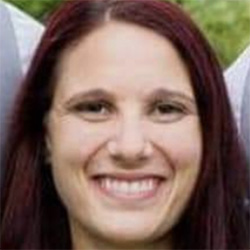Neelima Valangi was resting in a cold, snow-covered cirque before the rising sun hit it. Neelima had been hiking early in the morning to get to a glacial tarn. She couldn’t bring herself to care about the stack of human bones next to the frozen lake called Roopkund because Neelima was so cold and unhappy at a height of 4,800 meters in the Indian Himalayas. Neelima went on the trek in 2009. At that time, “Skeleton Lake” was thought to be a solved mystery, and the Roopkund walk was well on its way to changing the way Indian trekking was done. But after more than ten years, the small lake has become a victim of its own fame, and it still confuses people, even though huge steps forward have been made in our understanding of the past. The BBC chronicles the origin of the lake.
Beyond Skeletons: Roopkund Reveals Its True Magic (Despite the Chilling Past)
In 1942, an Indian forest worker named H K Madhwal found hundreds of human bones stacked in and around Roopkund Lake. He told everyone about the strange discovery: a secret lake where 300 to 800 people died in terrible accidents. The cold Himalayas continued to protect the bodies. Late in the 1950s, the public learned about the scary mountain find. It sparked a lot of interest and led to several probes that are still going on today. That wasn’t the main reason why Neelima or a lot of other hikers have gone to Roopkund in the last ten years. The main reason was the amazing views, varied scenery, and difficult trail.
The nearest town is five days away in the state of Uttarakhand. The more than 50 km, week-long walk starts in picture-perfect Himalayan villages with just a few traditional houses. After going through ethereal mist and moss-covered oak forests, the path goes along large alpine pastures with lots of wildflowers. These are called bugyals in the area and are only found above 3,300 meters in the Himalayas. Soon, tall Himalayan peaks appear and will rule the horizon for the next two days. At 5,000 meters, Junargali, a ridge that looks like a knife edge, is the highest point of the trek. From there, you can see the high Himalayas and the rough glacial scenery all around you.
Early Theories Regarding The Site

Roopkund is 200 meters below this peak. Because the path to JunargalNeelima Valangi is so dangerous and steep, hikers often joke that one wrong step could easily add to the pile of bones in the lake. After recent events, that simple joke doesn’t seem too far-fetched, even though Skeleton Lake first caught everyone’s attention almost 80 years ago.
At first, people thought the bodies belonged to Japanese soldiers or Tibetan traders on the Silk Road who had died of an illness or being outside in the weather. After a forensic investigation in 2004, the most likely explanation was that a group of Indian pilgrims, including men and women, were hit by huge hail at Roopkund in the 9th century, with the help of local porters. The injuries on the heads found after the deaths led to this conclusion.
Skeletons at Roopkund: Were They Pilgrims Caught in Divine Fury or a Deadly Downpour?
People thought they were on the Nanda Devi Raj Jat Yatra, a holy Hindu pilgrimage that only happens once every 12 years. This is an old practice that is still going strong today. Roopkund is on its way to Homkund, which is the end of this long, hard walk.
Veena Mushrif-Tripathy, an archaeology professor at Pune’s Deccan College, was involved in the 2004 inquiry. Because there were no weapons at the scene of the crime, the team came to the conclusion that the pilgrim theory was the most likely one. This meant that the deaths were not the result of an attack, and the people who died were not troops. They also found pieces of musical instruments and old stories about travelers who were on the Nanda Devi Raj Jat Yatra. Mushrif-Tripathy said that the DNA test showed that it was a group of men and women of different ages, which supported this theory even more.
From Whispers to Wanderlust: Roopkund’s Unforeseen Lure and the Cost of Untamed Tourism
People who told Neelima about the bones when she hiked to Roopkund gave a rough version of this idea. Also, they heard fantastic stories about angry gods, disrespectful pilgrims, and dancers who turned to stone. Every campsite, every pond, and a lot of other sites along the way were full of complex stories. The strange Roopkund became an interesting topic of study because it had both amazing nature and interesting lore.
So, it shouldn’t be a surprise that Roopkund sped up the commercialization of the Indian hiking scene without meaning to. In 2009, a company in Bengaluru started an online book, a cheap group trip to Roopkund. Indians’ disposable incomes were growing at the same time that the Indian Himalayas’ slopes became easier to reach. Until that point, only tough alpine types had been able to explore them.
Indian trekkers rushed to master the difficult but very rewarding Roopkund trek, as expected. After this company’s success, many more like it sprung up all over the country, promoting more trails in the Himalayas to meet the growing demand, which was later greatly increased by the rise of social media. Unfortunately, this commercialization has caused a lot of damage to nature in the Himalayas. Indians have never been to the Roopkund trek before, but you can’t go there now because the government doesn’t let people sleep in the over-used and fragile bugyals.
Roopkund’s Skeletons Crack Open: Ancient DNA Reveals Shocking Mix and Match Across Millennia!
Scientists quickly changed the way they study the past after sequencing the first genome of an ancient person in 2010. Soon, the secret of Roopkund came up again. 38 powdered bone samples from skeletal remains kept at the Anthropological Survey of India in Kolkata were sent to 16 labs around the world to be analyzed for genomics and biomolecular biology. When the study’s results came out in 2019, they shocked everyone.
The new study discovered that the 38 skeletons came from three genetically separate groups and were dumped in the lake at different times over a 1,000-year period. As expected, the bones of a group from South Asia were found at different times between the 7th and 10th centuries. The team also found a new group of people with eastern Mediterranean ancestry who came from the island of Crete and all died at the same time in the 1800s. Of the samples, one came from South-East Asia and was also from the 1800s. The team was surprised by this strange finding, so they looked at the person’s food to see if it matched the DNA results, which it did.
The Mystery Is Nowhere Close To Being Solved
“Using aDNA [Ancient DNA] gives us direct information about the genetic ancestry of these people at a site like Roopkund where the context is highly disturbed and full-scale excavations are not possible,” said Ayush Neelima Valangi Nayak from the Max Planck Institute for the Science of Human History. “Our 2019 paper added new types of data by using various biomolecular techniques.“It was a surprise to find new proof that non-Indian groups were at Roopkund Lake. There is no historical evidence to explain who these people were or what they were doing so far up in the Himalayas.
“There are still questions about the group of people whose ancestry was most like that of people from the eastern Mediterranean today. For example, they don’t know why they came to Roopkund or if they were European tourists or locals with eastern Mediterranean ancestry.” Or about whether there are other places in the area with as many human remains,” Nayak said.
Roopkund: Where Beauty Hides a Baffling History
Minds are spinning as trekkers think about the trip to Roopkund today how complicated the mystery is and how heavy the history of the path they walked on so casually is. On good days, the high Himalayas are stunningly beautiful, but on bad days, they can be very dangerous. Over the past ten years, many people have died while trying to find Roopkund.
But what drove all of those who died too soon at this lake hundreds of years ago, including the strange group from the eastern Mediterranean? Neelima Valangi also had a question: how did they all die? They laughed that maybe some of them fell off the Junargali hill. Could some of them have died from being outside, as they thought? Some of them may have died from acute mountain sickness, which is very common at this height.
It is not likely that different groups of people died at Roopkund in different hailstorms over more than 1,000 years. Still, that’s the only proof they have right now. Mushrif-Tripathy, who was also part of the 2019 study and a co-author on the new paper, said, “There are only about six or seven skulls that have damage from hail.” “From her point of view, the mystery is still open.” There are more questions than solutions for us.
Skeletons Unsettled, Secrets Unfurled: Roopkund’s Grim Riddle Deepens
The place is still very much disturbed and not well taken care of. Trekkers have moved skeletons around over the years and even taken some home as gifts. This makes it harder to find a correct answer in the future, even if science makes progress. The strange results of the 2019 study have caused a lot of buzz, which is understandable. But the more important thing to think about is what other surprises are buried in the icy grave if a thinks of only 38 samples out of hundreds of people threw such a curveball?
While they scratch our heads in confusion and wonder, the skeletons in the lake keep puzzling us. The riddle of the dead goes on at Roopkund.
This content has, in part, been generated with the aid of an artificial intelligence language model. While we strive for accuracy and quality, please note that the information provided may not be entirely error-free or up-to-date. We recommend independently verifying the content and consulting with professionals for specific advice or information. We do not assume any responsibility or liability for the use or interpretation of this content.

